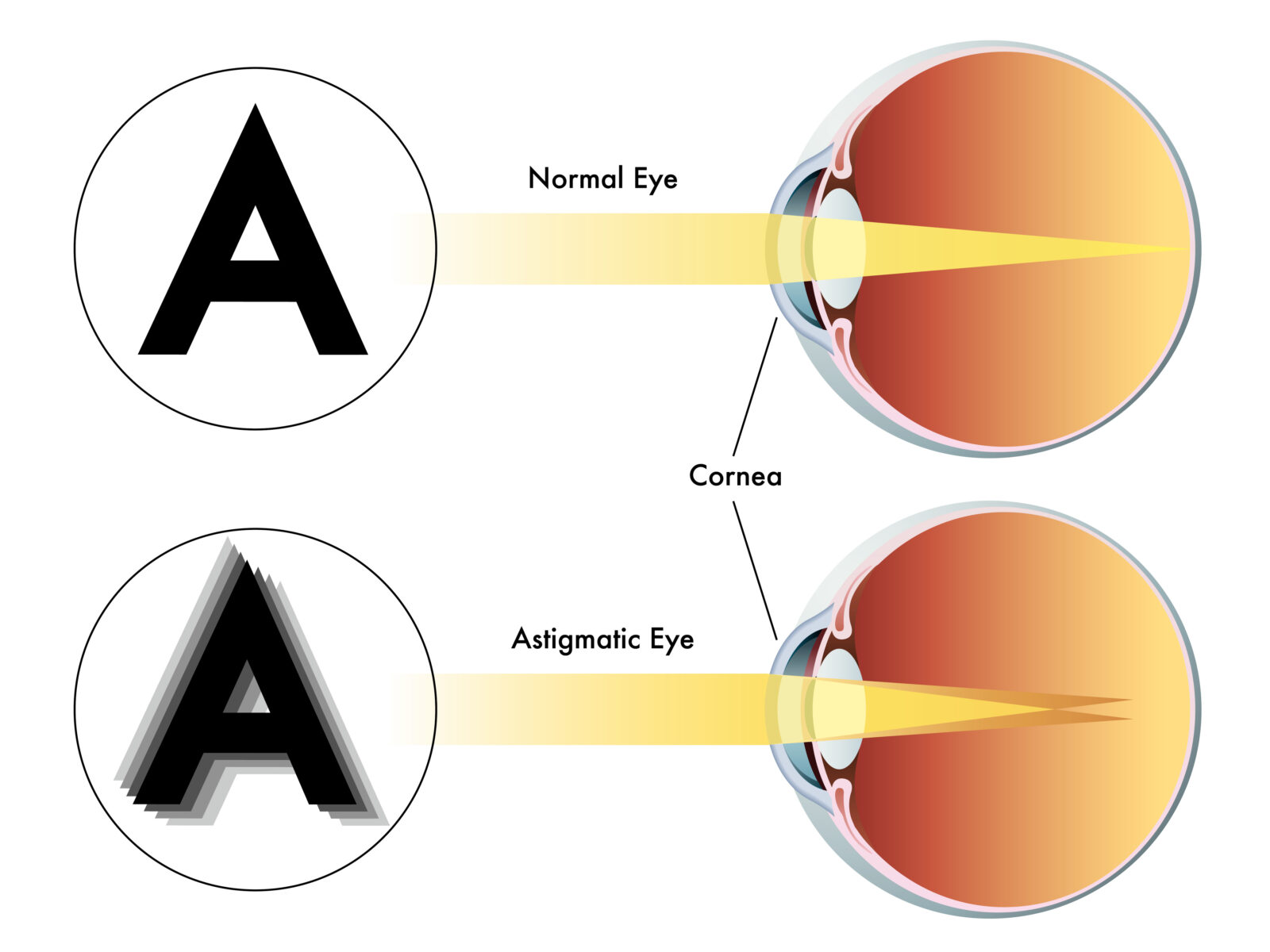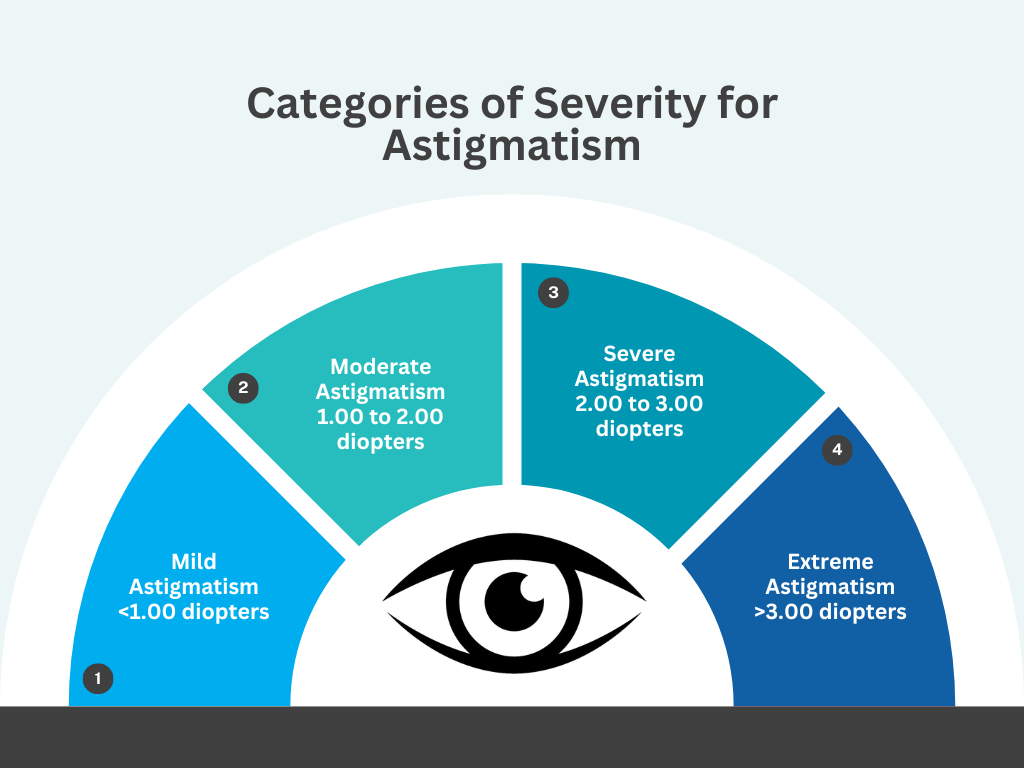What is Astigmatism?
Astigmatism occurs when your cornea is shaped like an egg. With astigmatism, more than one focal point within the eye distorts what you see. As a result, you experience a tilting of images due to the unequal bending of light rays entering your eyes.
Many patients with myopia and hyperopia have some degree of astigmatism, or an oval shape, to their cornea. People with high degrees of astigmatism have blurred vision for both near and distant objects.
Normal Vision:
Good vision depends on light rays being precisely focused on the retina at the back of the eye. The optical system, comprised of the cornea, crystalline lens, and vitreous body, refracts or bends light so it lands directly on the macula – the point of best vision on the retina. This refraction, measured in diopters (D), involves the different parts of the optical system working together. Zero diopters means light focuses right on the retina, allowing sharp images. Any deviation from zero diopters indicates a need for vision correction to sharpen the view.

Astigmatism:
Astigmatism Causes Blurred Vision When the Cornea Has an Irregular Shape
Typically, the cornea has a smoothly curved, spherical shape like a ball. With astigmatism, the cornea is more irregularly shaped, resembling an egg. This causes light to focus at multiple points in front and behind the retina rather than one sharp focus on the retina. The uneven corneal curvature refracts or bends light differently based on the direction – vertical versus horizontal rays. The resulting distorted image may make a dot look like a line.
Exploring Treatment Options, Including LASIK Surgery
For those eligible, LASIK surgery is a viable option for correcting astigmatism. However, not everyone qualifies, and the exact corneal shape is a crucial factor. Consultation with an eye doctor is essential to determine the suitability of LASIK surgery and explore other treatment options.
LASIK Surgery: While many individuals qualify, those with astigmatism beyond recommended parameters may not be eligible. Consultation with an eye doctor is necessary to assess the suitability of LASIK for astigmatism and discuss alternative treatments.
Types of Astigmatism and Their Impact on Vision
Astigmatism often coexists with farsighted or nearsighted vision, causing blurred vision and distortion. Nearsighted astigmatism focuses light in front of the retina, resulting in blurred distance vision. Farsighted astigmatism, on the other hand, causes light to focus behind the retina, making close-up objects appear blurry. Hyperopic astigmatism, myopic astigmatism, and mixed astigmatism are specific variations, each contributing to unique visual challenges.
- Hyperopic Astigmatism: Found in farsighted individuals with an astigmatic refractive error.
- Myopic Astigmatism: Affects nearsighted individuals with an astigmatic refractive error.
- Mixed Astigmatism: Occurs when an eye is both nearsighted and farsighted, causing blurriness at various distances.

Factors Increasing the Risk of Astigmatism
While astigmatism is common, certain factors increase the risk. Family history plays a significant role, and individuals with a genetic predisposition should inform their eye doctors. Additional risk factors include high prescriptions of myopia or hyperopia, maternal smoking during pregnancy, ethnic background, a history of eye surgery, and traumatic eye injuries.
Key risk factors:
- Family history
- High myopia or hyperopia prescriptions
- Maternal smoking during pregnancy
- Black or Hispanic ethnicity
- History of eye surgery
- Traumatic eye injury
Diagnosing Astigmatism Through Comprehensive Eye Exams
A thorough eye examination is crucial for diagnosing astigmatism. Tests such as visual acuity, refraction, and keratometry help determine the extent of astigmatism and guide treatment decisions.
- Visual Acuity Assessment: Measures the eye’s ability to discern details from a distance, often using a chart with letters.
- Refraction: Determines the refractive error, including astigmatism.
- Keratometry: Measures the curvature of the cornea, identifying irregularities associated with astigmatism.

Understanding the types of astigmatism, recognizing risk factors, and undergoing regular eye exams are vital steps toward maintaining clear vision. If considering LASIK surgery, consult with a qualified eye care professional to explore the best treatment options for your specific needs.
Source:
What Is Astigmatism? Symptoms, Causes, Diagnosis, Treatment. (2023, November 14). American Academy of Ophthalmology. https://www.aao.org/eye-health/diseases/what-is-astigmatism